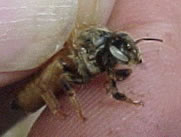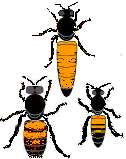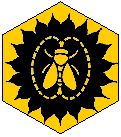 Simple Genetic Traits of the Honeybee Simple Genetic Traits of the Honeybee
Some traits of the honeybee are controlled by single dominant and recessive genes just like Mendel discovered with his peas.

 There are several different eye colors of bees that work this way. They are interesting to play with, and a good way to see for yourself how genes work. There are several different eye colors of bees that work this way. They are interesting to play with, and a good way to see for yourself how genes work.
This mutation is called ivory and is a simple single gene recessive trait. A female must have two copies of the gene to express white eyes. Drones can have only one copy, so they always express whichever they have, either black or white. In this picture of two drones hatching, one with black and one with white eyes, we know that the queen must have had black eyes but was carrying the recessive white eye gene. 
 No genes can hide in a drone, all his genes are expressed, so recessive traits are much easier to find and select in drones. This is a great advantage we have with bees that isn’t possible in ordinary diploid animals. Haploid selection is a very effective way to select for genes. Unfortunately, most traits we are interested in are behaviors of workers, so this powerful technique is not utilized except for traits like color. Perhaps when we can easily read the DNA directly, this will be a very powerful selection technique. These tools for us are probably not far off, I think within our lifetimes. No genes can hide in a drone, all his genes are expressed, so recessive traits are much easier to find and select in drones. This is a great advantage we have with bees that isn’t possible in ordinary diploid animals. Haploid selection is a very effective way to select for genes. Unfortunately, most traits we are interested in are behaviors of workers, so this powerful technique is not utilized except for traits like color. Perhaps when we can easily read the DNA directly, this will be a very powerful selection technique. These tools for us are probably not far off, I think within our lifetimes.
 Mendel struggled to understand inheritance in bees as well as peas. He went so far as to construct a confined mating chamber to control the queen mating, but without success. Nobody knows what Mendel would have discovered if he had instrumental insemination as a bee breeding tool back then. I wish he could see all the results of what he started with his discovery of the gene. I think we are just at the beginning of understanding how genes work in bees. But when you think of how far we’ve come from his discoveries of how genes work, to the honeybee genome being sequenced in a little over 100 years, I think Mendel would have been pleased. Mendel struggled to understand inheritance in bees as well as peas. He went so far as to construct a confined mating chamber to control the queen mating, but without success. Nobody knows what Mendel would have discovered if he had instrumental insemination as a bee breeding tool back then. I wish he could see all the results of what he started with his discovery of the gene. I think we are just at the beginning of understanding how genes work in bees. But when you think of how far we’ve come from his discoveries of how genes work, to the honeybee genome being sequenced in a little over 100 years, I think Mendel would have been pleased.
Cordovan color is a simple recessive trait
 The cordovan body color is also controlled by a simple recessive gene. It changes the The cordovan body color is also controlled by a simple recessive gene. It changes the  black parts of the bee into black parts of the bee into  brown. The cord brown. The cord ovan trait is independent from the the normal black or yellow body colors. ovan trait is independent from the the normal black or yellow body colors.
We usually produce only the Italian bees with the cordovan trait, but dark bees like carniolans can also be produced, their body color comes out this bronze color.
The color of bees is usually considered trivial, not really correlated with other traits, but it is often interesting to have different colored bees to be able to track them. For instance you can observe how far away your cordovans are foraging when you see them on flowers, or the pattern of bees drifting between hives in an apiary. It’s also interesting to observe how long bees live and what jobs they are doing at different ages, when a queen of one color is introduced into a colony of another color.
Once again notice that the females must have two copies to express a recessive trait while the drone expresses whichever single copy he got from the queen. It's also clear that the queen alone determines the genotype of the drone, not who she mated with.

|

|
 Glenn Apiaries
Glenn Apiaries